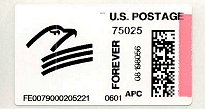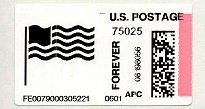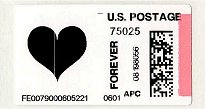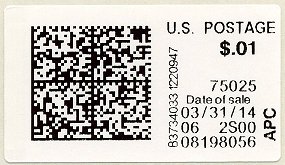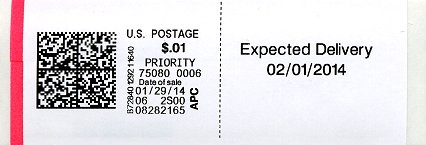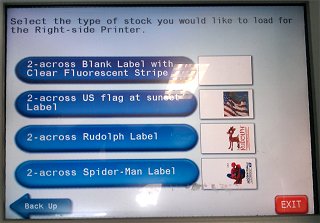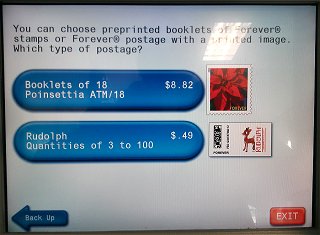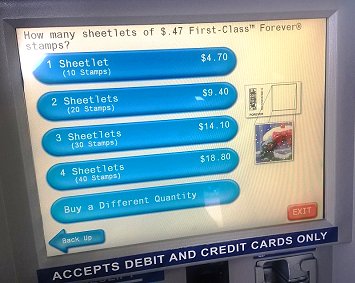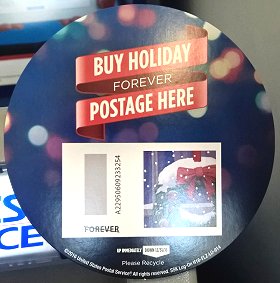| UNITED STATES. APC / SSK issues |
|
 |
| The 'Automated Postal Center' project. Introduction |
The use of stamp vending machines started at the beginning of the twentieth century, and was very common in the United States. In the late 1980s, in a strategy designed to introduce self-service equipment in which users could access basic postal operations, the American postal service (USPS) developed a self-service platform (SSP), which evolved to become the Automated Postal Center project, in 1998.
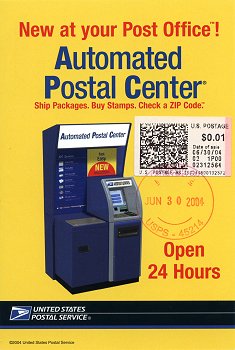 |
The Automated Postal Center (APC) is a self-service postal kiosk allowing users to access the most common postal services and products, 24/7. For the postal company, the installation of this equipment allowed it to increase and improve its offerings, whilst saving money by allowing postal employees to dedicate their time to more specialized operations and providing a higher return. For postal customers, the use of these machines assumes that they can organise their own needs both quickly and easily, without special assistance, thus avoiding the long queues at the counters.
After various trials, USPS decided to purchase the APC postal kiosks manufactured by Wincor Nixdorf and IBM. The first machine was installed on April 14th 2004, in Dallas, Texas. From that date until November of that year, a total of 2,506 APC kiosks were installed, mainly in the lobbies of post offices across the country. |
 |
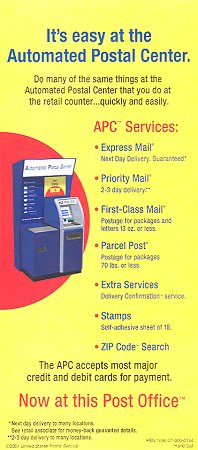 |
The APC was developed from the basic banking kiosk – the Wincor Nixdorf ProCash 1500 ATM, modified according to the needs of the USPS, to allow the sale of sheets of stamps, as well as the weighing of postal items and printing of stamps. The kiosk includes a 15-inch colour touch screen that informs users about the available services, products and information.
At the left, the APC has a unit developed by IBM, which includes the scale for weighing items. |
Inside the main unit, the APC postal kiosk has a thermal printer for printing receipts, and another two located inside the side unit, below the scale. These two thermal printers are used (1) for the printing of large size stamps for packets, and (2) the printing of variable value or print-on-demand stamps (right picture).
After purchase, the kiosk accepts payment by debit and credit cards. As an additional security measure, the machine takes a picture of the customer using the bank card, by means of a digital camera located below the screen. |
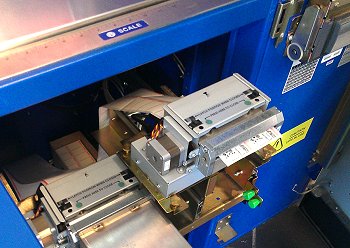 |
The APC kiosks run using a software application developed by IBM, that adapts and integrates this self-service equipment to the USPS point-of-sale network.
At the beginning of the installation, APC kiosks offered three basic options; (1) buy stamps (in sheets of 18 preprinted self-adhesive stamps for domestic mail, or variable value stamps), (2) mail a letter or packet, by using the scales, and (3) obtain information about ZIP codes. In the following years, further software upgrades added more options and services (right image). |
 |
| Test label issued by a Wincor Nixdorf ProCash 1500 APM postal kiosk installed at Post-Expo 2005. |
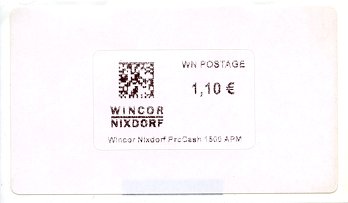 |
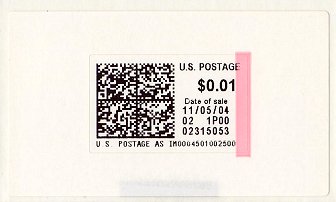 |
The APC postal kiosks could issue variable value stamps with any face value between $0.01 and $99.99. The stamps were printed on self-adhesive white labels on thermal paper, including a vertical fluorescent strip on the right, in a pink colour. The size of the stamp is 42 x 26 mm., although the size of the large self-adhesive label is 85 x 49 mm. |
The APC stamps include a two-dimensional code on the left, and the face value, the purchase date, and different control codes in the righthand half. '1P00' identifies the label supplier, Pitney Bowes.
| By using the 'mail a letter' option, it was possible to obtain stamps to suit the shipment type requested, and which was printed under the matrix code. During the early months, the 5 shipment options were 'U.S. POSTAGE', 'PRIORITY MAIL', 'FIRST CLASS', 'PARCEL POST' & 'INTERNATIONAL'. |
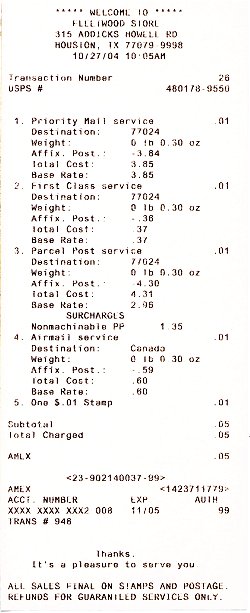
|
 |
 |
 |
 |
 |
The righthand picture shows the long receipt (79 x 196 mm.) on thermal paper, issued after the purchase of the 5 above stamps.
The Automated Postal Centers were slow and noisy, with some operations requiring a long wait, so various changes and upgrades were carried out over the following years.
Despite including the date of purchase, these stamps could be used as 'traditional' stamps, for use at any time and place. |
From late 2004, an upgrade to the software changed the information contained in the APC stamps.
| A control code preceded by the shipment type initials was included under the matrix code. On the right, the face value in a smaller size. Next, the shipment type ('FCM' -First Class Mail- in the stamp below, and 'PRIORITY' in the large size stamp for packets), and the ZIP code of the postal kiosk (45214 in both cases). All stamps also include the letters 'APC', vertically on the right, next to the fluorescent strip. |
 |
 |
| 2012. The evolution of the APC postal kiosks. The APC - FOREVER stamps |
 |
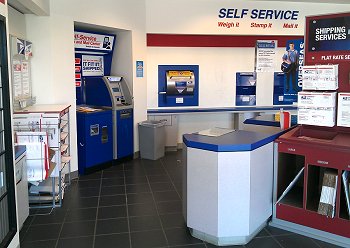 |
Towards the end of 2011, the USPS began the transformation of the APC (Automated Postal Center) to the new SSSMC (Self-Service Ship and Mail Center), with changes in equipment, menu options and selection screens.
This change was extended to about 2,500 APC postal kiosks in service, between April and September 2012. |
On April 12th 2012, the USPS started a pilot in 10 post offices where the new SSSMC postal kiosks no longer sold the sheets of 18 preprinted stamps for domestic mail. Instead, the machines printed on-demand domestic mail stamps (with a face value indicator of 'FOREVER') and, for the first time, allowed the customer to select the stamp design from 6 different options (right): balloons, eagle, US flag, flowers, Mr. ZIP, and heart.
Note that these stamps have no variable value rate, as they could only be issued for domestic mail with the face value indicator 'FOREVER'. |
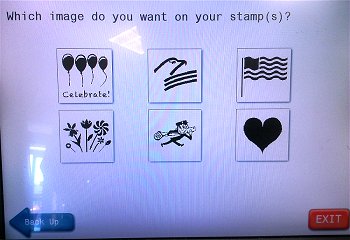 |
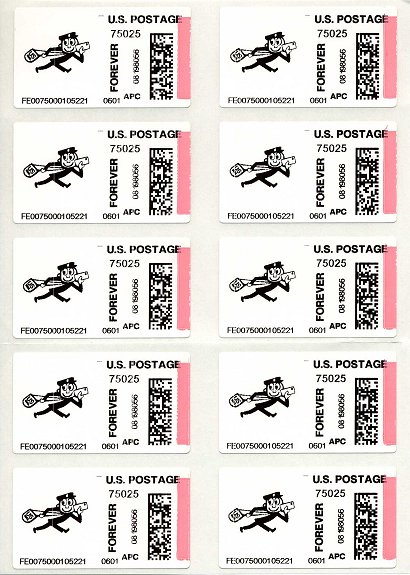 |
After the design selection, these stamps were printed in sheets of 10. The printer was fed by packs of sheets of 10 thermal self-adhesive labels, arranged in 5 rows of 2 columns, and were fan folded. The size of the labels is 47 x 26.50 mm., and include a vertical fluorescent strip at the righthand side, preprinted in different shades of rose-orange-red.
Lesser amount of stamps would be issued in blocks of 2, 4, 6 or 8.
In the sheet on the left, the user selected the Mr. ZIP design, the cartoon character used by the American Postal Service since 1963 to promote the use of the ZIP code. The domestic mail value indicator 'FOREVER' is printed, edgeways, in the centre of the stamp, giving a theoretical indefinite validity to the stamps. However, thermal printing of such stamps whilst of good quality has low durability, and the information fades over time. |
 |
If the purchase was for a single stamp, or the quantity required was odd, the last unit of the block was a label without postage value labelled 'THIS BLOCK IS NOT VALID POSTAGE'. |
| When the postal kiosk could not print the requested stamps on the corresponding sheets, due to technical problems or because of the depletion of the sheets of labels, the printing was transferred to the thermal printer which issues large size packet stamps. The size of the resulting stamps is 101.30 x 38 mm., and are issued with the words 'FOLD HERE', to tell the |
 |
user to fold the label around the edge of the letter, on the dotted line, so that the information on the stamp is perfectly aligned for recognition by postal scanning equipment. |
The 6 'FOREVER' b/w designs were available from the SSSMC postal kiosks until November 5th 2013, except for a short periods in which the machines used special labels with colour designs (see following sections).
| The APC / SSSMC variable value stamps |
The variable value stamps are obtained by pressing the 'Buy stamps' or 'Mail a letter or Package' options, in the main menu.
In the first case, the user can select the face value required, starting from $.01, and obtain a stamp with the face value only (image below).
With the 'Mail a letter or Package' option, the user must place the postal item on the scale, enter the destination ZIP code, and choose the shipment type and other services available. The result is a variable value stamp, which includes the face value and the indication of the shipment type. The system ask the user if the item has a prefranking, after which it is possible to obtain a franking complement stamp with the service inscribed on it, with the face value starting from $0.1.
 |
These stamps are printed on the same sheets of self-adhesive white labels as those used for the 'FOREVER' b/w designs, but now the size (47 x 26.50 mm.) is larger than the stamps issued by the original APC equipment (42 x 26 mm).
Despite the transformation of the postal kiosks, the new stamps still includes the APC text. |
The large size self-adhesive stamps for packets (101.30 x 133.50 mm.) are also printed on thermal paper, and includes a continuous fluorescent strip, pre-printed in pink, on the left edge.
In total, up to 18 different shipment type indicators are available on the variable value stamps, plus stamps with just the face value (upper image), and 21 in the case of stamps for packets ('EM LFR ENV' - EXPRESS MAIL, shown in the right stamp). |
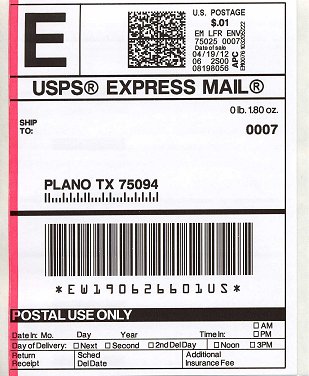 |
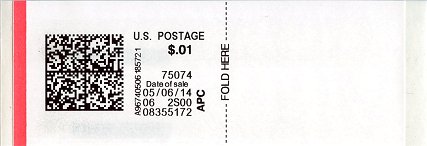 |
As for the 'FOREVER' issues, if any problem prevents the correct imprint of the stamp or stamps on the sheets of labels, printing is transferred to the printer for packet stamps, and the resulting stamp is labelled 'FOLD HERE'. |
| 2012. The first colour design, 'Mailbox' |
In late October 2012, the USPS announced the upcoming introduction of new pictorial labels in the APC/SSSMC postal kiosks, during the Christmas holidays. It was the first time that postal kiosks used sheets of self-adhesive thermal labels with a preprinted colour design.
The new sheets of labels began to be used progressively from November 10th 2012, and were available -except when stocks were depleted- up to January 2013, when the postal kiosk software was changed again to continue with the issuing of the 6 b/w 'FOREVER' designs.
These sheets arrived at post offices in boxes of 13,000 labels, 1,300 sheets of 10 labels, fan folded and with a die-cut between sheets (see below). |
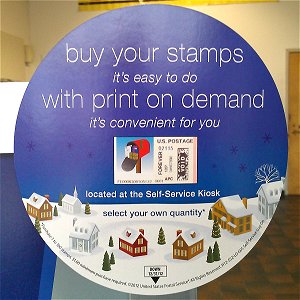 |
A special upgrade to the software for the postal kiosks showed the new design to the users, and offered them the chance to purchase sheets of 10 stamps.
In the new configuration, the stamps include the printing of the month and year of purchase (MM*YY), vertically at the right of the face value indicator. |
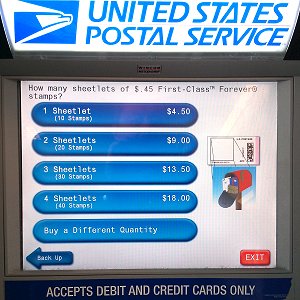 |
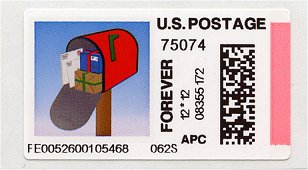 |
 |
The preprinted design shows a traditional American mailbox, filled with letters and gift packets.
As in the previous application, these stamps (and all subsequent releases) are not variable value - These stamps could only be obtained for domestic mail and labelled 'FOREVER'. |
| This special design was available in sheets of 10 stamps. If the user requested a lesser quantity, the stamps were issued in blocks of 2, 4, 6 or 8 stamps. |
 |
For odd quantities, the last piece of the block was a label without postage value, and a new text 'VOID - THIS BLOCK IS NOT VALID POSTAGE'. |
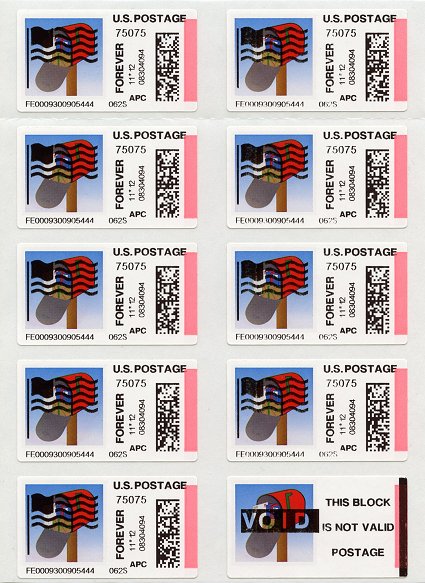 |
This new issue replaced, temporarily, the 6 b/w 'FOREVER' designs. To do this, the post office staff had to
(1) replace the white label sheets, with only the fluorescent vertical strip, for the new sheets of 10 labels which also included the holidays design, and
(2) select the appropriate software, so during that period the 6 design options were not available.
Of course, the omission of one of these two actions caused the appearance of numerous errors and strange combinations. In the blocks on the left, for example, the label sheets were replaced, but the application preventing the selection of design remained unchanged.
In this type of label sheet, thermal printing on the preprinted design has proved to have very poor durability, and printing on the color surface fades rapidly. A real shame for all interested in collecting these stamps. |
 |
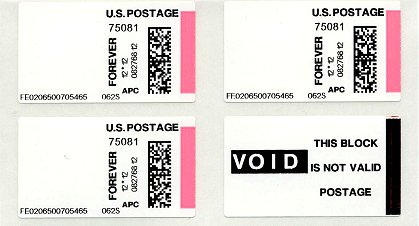 |
The left image is an example of another erroneous combination. The staff selected the correct software for the special 'mailbox' design, but did not replace the sheets of labels (or those exhausted). The kiosk printed the 'mailbox' imprint configuration on sheets of white labels, those used for the 6 b/w designs. |
| 2013. The basic design 'USPS logo' |
| From late October 2013, the USPS made a new change in the SSSMC postal kiosks. The 6 b/w 'FOREVER' designs were replaced by a new b/w basic design with the well known logo of the United States Postal Service, the stylised profile of an eagle's head. |
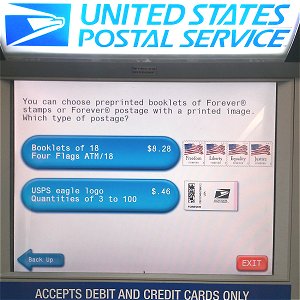 |
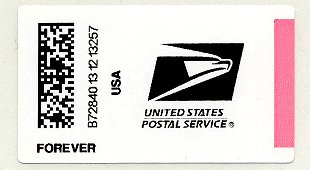 |
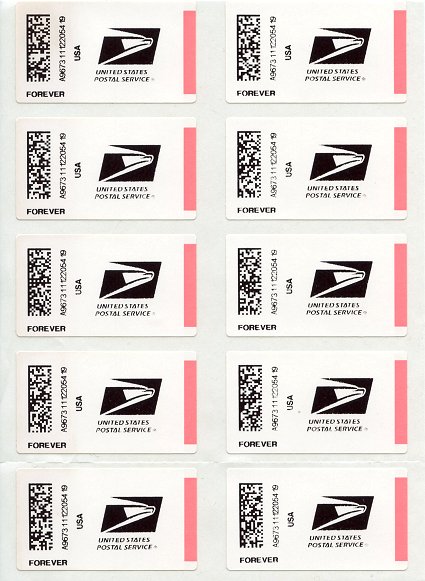 |
But now in the new configuration, the information printed on the stamp was reduced, and displaced to the left. There is the 2-D matrix code, and a code composed of a letter (B in the above stamp), the kiosk identification (the 4 numbers following the letter, 7284), the date of purchase (MMDD - 0131), and a control number. The face value indicator 'FOREVER', the only value available for all these releases, is printed in the lower left corner.
As with previous designs, postal kiosks used sheets of 10 self-adhesive labels on thermal paper, with a preprinted fluorescent strip in different red-orange-pink shades, vertical at the right of the label. These sheets are fan folded, with a horizontal die-cut, as can be seen in the left sheet, between rows 4 & 5.
During 2013, this new design was available only for a few days and from a few postal kiosks, as the USPS released a new special Christmas design.
|
 |
New label sheets were introduced in late 2013. In these, the fluorescent pink strip on the right side was replaced by a colourless fluorescent strip, on the left. |
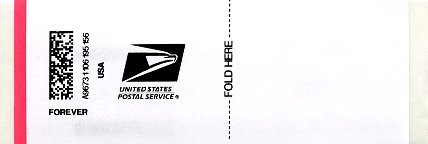 |
The 'FOLD HERE' stamps are obtained when the kiosk does not have (or cannot use) the adequate sheets of labels, and transfers the printing to the thermal printer using the larger size packet stamps. |
| 2013. The special holiday issue, 'reindeer' |
| A few days after the introduction of the basic b/w design, the USPS launched a new special holidays design, with the image of a Christmas reindeer. This option (right) was available in some postal kiosks from early November, and nationwide from November 15th 2013. |
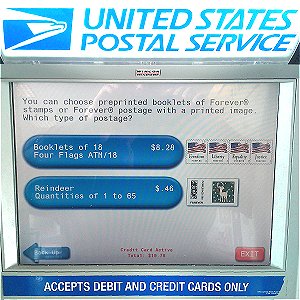 |
 |
This issue is the first preprinted design in which the usual upright fluorescent pink strip was replaced by a colorless fluorescent strip, visible under ultraviolet light, on the left of the label.
From this issue, all the subsequent designs also incorporate this fluorescent strip. |
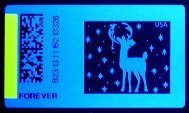 |
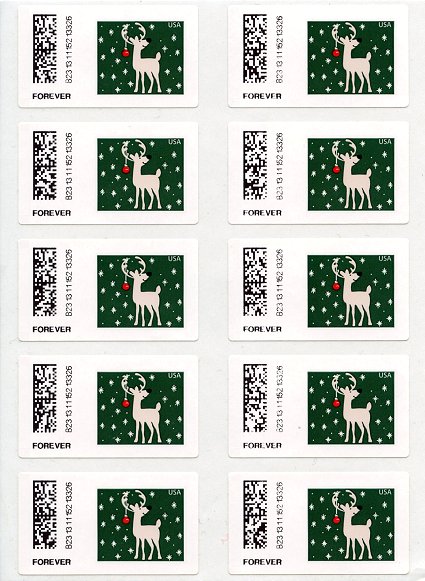 |
The introduction of this new preprinted design in postal kiosks involved a modification to the thermal printing software, removing the name 'USA', which is already printed in the label design.
These software modifications were not remotely activated, but handled by the post office's staff, who had to choose the appropriate version according to the label sheets used.
It is inevitable that the selection of an incorrect version would result in the appearance of wrong combinations.
Such is the case of the two examples below. In the first example, the postal kiosk was loaded with the appropriate sheets, with the special 'Reindeer' design, but the application was unchanged, and the postal kiosk continued printing stamps with the basic 'USPS logo' superimposed on the pre-printed design.
The image below shows an example of a stamp plus a non-postage value label with the printing version adapted to the holidays design, but on white labels, intended for the basic design ...
Like the first special Christmas issue, this design was available from postal kiosks until the end of the holidays, or until depletion of stock. |
 |
 |
On March 17th 2014, during the National Postal Forum held in Washington, the USPS announced a partnership with the feature film The Amazing Spider-Man 2, which premiered in the United States, on May 2nd.
| This partnership established the special release of stamps, to be issued by the APC/SSSMC postal kiosks, and were dedicated to the film and featuring Marvel Comic’s superhero Spider-Man (images below), as well as the launching of a branded Priority Mail flat-rate boxes (right). |
 |
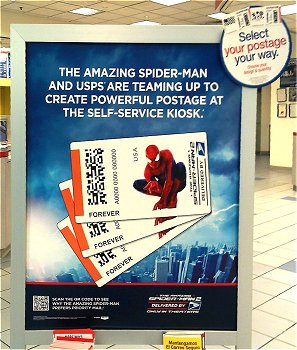 |
 |
Related promotional material in post offices.
Above, the postal kiosk screen with the options available selecting the 'Buy stamps' option. |
The new design had to be available from some selected postal kiosks from April 1st 2014, although it was used in a few kiosks a few days before the official date set by USPS. In the picture below, the stamp was issued on the first official day of issue (B37340401134249, in the upright code). On the right, a blank label, with no printing value.
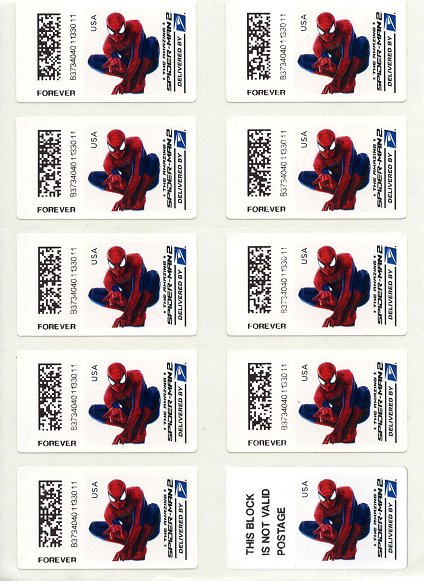 |
The USPS planned to issue this design for two months only, until May 31st, or until stock depletion, although some kiosks continued using this design for several months later than planned.
The left image shows a sheet with 9 stamps for domestic mail 'FOREVER', the only postage option available, and a label without any postage value 'THIS BLOCK IS NOT VALID POSTAGE'.
Like previous special designs, the lack of training (or oversight) of some postal employees, caused the wrong selection of the different versions of software to be used in the postal kiosks, and along with the use of different types of sheets, again caused the printing of stamps with wrong combinations. Unfortunately, in terms of collecting, the surface coating on the design area does not allow proper thermal printing, which fades very rapidly. |
| 2014. The basic design 'US flag' |
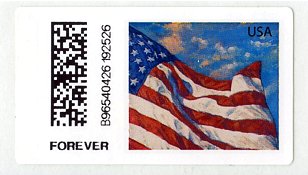 |
Along with the special design The Amazing Spider-Man 2, the USPS released a new basic label design for postal kiosks, for the first time in full color and featuring the US flag.
The official date of issue was April 1st 2014, although the earliest known stamps were issued a few days later. |
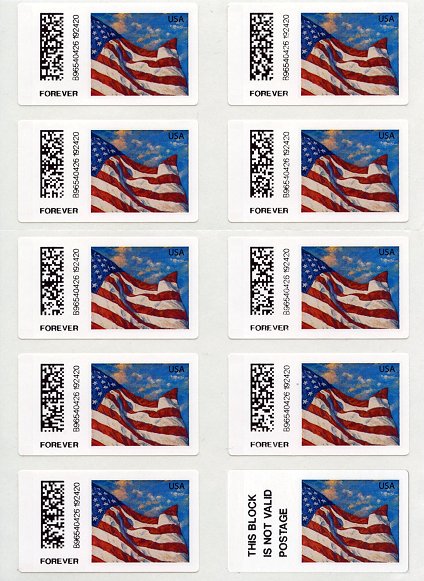 |
It is expected that postal kiosks use this design by default, as a basic design, being temporarily replaced by the new promotional or special releases, such the holidays/Christmas designs.
Exceptionally, when the stock of colour design labels is exhausted, the post office staff can reprogram the machines, and use the white label sheets and come back to the application printing the basic design 'USPS logo'. |
| 2014. Rudolph, the special holidays issue for APC postal kiosks |
In 2014, the third special preprinted design for the Christmas holidays is illustrated with the image of Rudolph, the Red-Nosed Reindeer who, according to Christmas tradition, guides Santa's sleigh on the night of December 24th.
USPS
made November 6th the first official day of issue, although it was available, in most APC postal kiosks, from mid-November.
On that same date, USPS put on sale a Christmas set of 4 self-adhesive stamps, issued in booklets of 20 for domestic mail, and illustrated with images of 'Rudolph the Red-Nosed Reindeer'. This was a popular television series first aired on December 6th 1964.
Following the release date, and for the next 30 days, a special pictorial first day postmark was available at the post office of Rudolph, a small town in the state of Wisconsin. |
 |
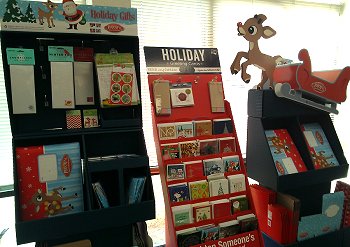 |
 |
| Packaging and cards illustrated with the Rudolph design, on sale in US post offices during the Christmas season. |
The images below correspond to two screens from the APC postal kiosks.
The left image is a internal usage screen, only accessible to the kiosk maintenance staff. This screen allows them to decide on the label design to be used and issued by the machine. In late 2014, the four options available were blank labels, the American flag, Rudolph and Spider-Man. The selected design becomes the image appearing on the user screen when buying domestic stamps, with the face value indicator 'FOREVER' ($ 0.49 at the date of issue) (right image), and also the machine imprint configuration.
The Rudolph design arrived at post offices in boxes of 13,000 self-adhesive labels. Each box contains 1,300 sheets of 10 labels, fan folded and die-cut between sheets. The size of the labels is 47 x 26.50 mm., and are manufactured on thermal paper with a colourless upright fluorescent strip, visible under ultraviolet light, on the left of the label. On the right is the preprinted design on a glossy surface coating.
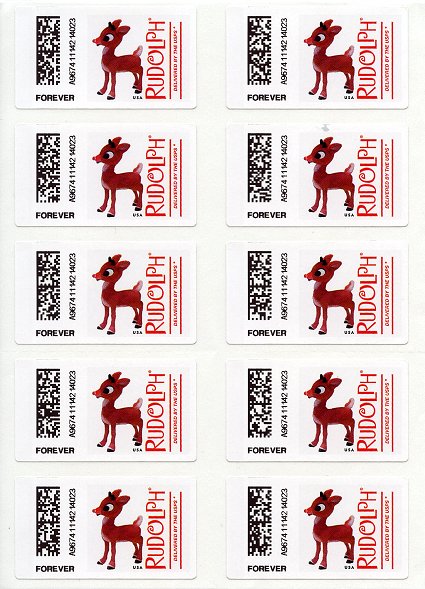 |
The left image shows a sheet with ten 'FOREVER' stamps for domestic mail, the only postage option available for this design. Because of the characteristics of the sheets with two columns of labels, stamps may only be issued in multiples of two. If the customer requests an odd number of stamps, the last label is issued with the text 'THIS BLOCK IS NOT VALID POSTAGE' (upper image), indicating that it has no postage value.
The wrong selection of the label design on the staff selection screen, (for example, blank labels and the Rudolph sheets), produced stamps with wrong imprints, on the preprinted design area. As stated in previous articles, in terms of collecting, the surface coating on the design area does not allow for proper thermal printing, and fades very rapidly.
The lower block corresponds to two test imprint labels 'TEST VEND VOID', and two blank labels. |
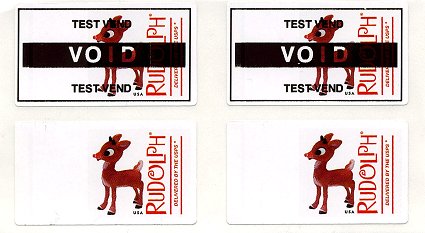 |
| The new SSK variable value stamps |
Towards the end of 2011, the USPS began the conversion of the APC (Automated Postal Centre) postal kiosks to the new SSSMC (Self-Service Ship and Mail Centre), with changes in equipment, menu options and selection screens (see article, also published in VARIABLE 34).
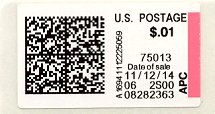 |
However, despite this transformation, the variable value stamps obtained by selecting the 'Buy stamps' or 'Mail a letter or Package' options still include the APC text, printed upright in the right lower corner. |
 |
In mid-November 2014, the US Postal Service renamed the postal kiosks as 'Self-Service Kiosks', and replaced APC with the text SSK. |
| Christmas 2015 with Charlie Brown |
In 2015, for the fourth consecutive year, the U.S. Postal Service (USPS) released a special design, for the Christmas season, using the APC (Automated Postal Centre) / SSK (Self-Service Kiosk) postal kiosks.
This new design is dedicated to Charlie Brown, and celebrates the 50th anniversary of the premiere of 'A Charlie Brown Christmas', the first animated TV special based on the newspaper strip 'Peanuts' by Charles M. Schulz. The animated film, 25 minutes long, was first aired on December 9th 1965, and since then has been aired during the Christmas season, traditionally, every year.
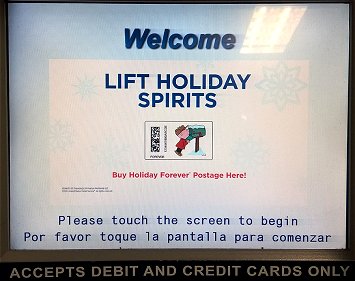 |
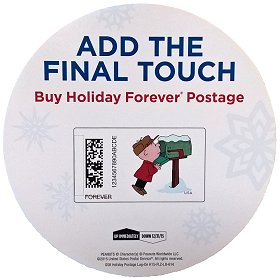 |
As in previous years, the design used on the self-adhesive labels for postal kiosks, is associated with an issue of seasonal stamps. In this case, a booklet with twenty self-adhesive stamps for domestic priority mail ('Forever'), illustrated with ten frames of the television special.
This booklet was released on October 1st 2015, to commemorate the 'Peanuts' comic strip debut in seven US newspapers, on October 2nd 1950.
The design used for the labels corresponds to the central motif of the stamp with Charlie Brown checking his mailbox for a Christmas card. |
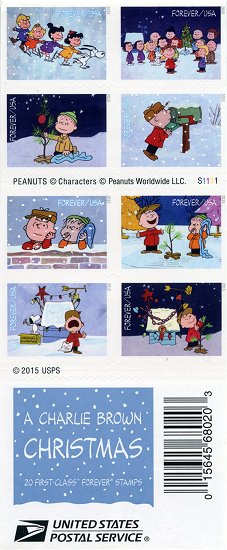 |
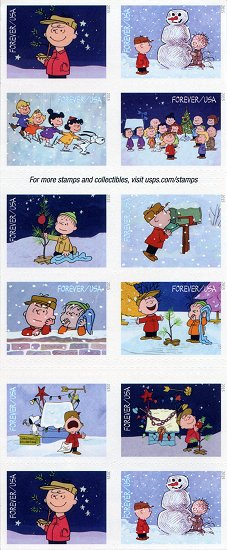 |
USPS set October 30th as the first date of use of the new Charlie Brown design in APC / SSK postal kiosks, although the stamps are issued prior to that date.
The distribution of the boxes with the sheets of labels was carried out in different stages, and many post offices received the Christmas labels during the month of November. |
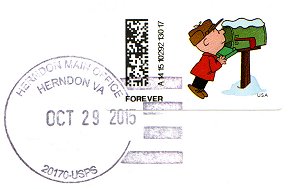 |
For the printing of the stamps, the APC / SSK kiosks uses sheets of 10 labels, fan folded and die-cut between sheets. The size of the labels is 47 x 26.50 mm., and are manufactured on thermal paper with a colourless upright fluorescent strip, visible under ultraviolet light, on the left of the label. The preprinted design is on the right, and has a glossy surface coating.
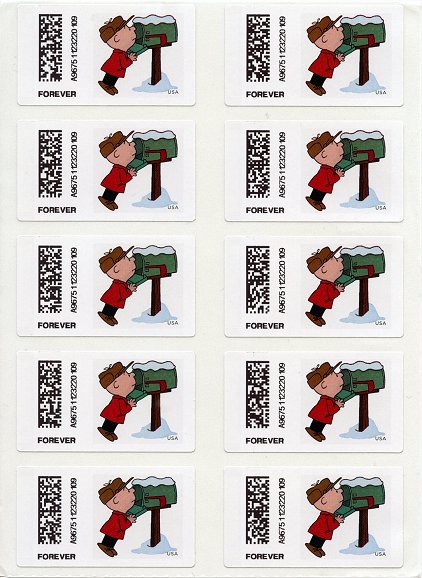 |
Postal users can only obtain stamps with this design with the 'FOREVER' value, the identifier of postage for domestic priority ('First-Class') letters up to one ounce, approximately 28 g. Therefore, these are not variable value stamps, because this design can't be obtained with other face values.
The sheets include five rows and two columns of labels (left) and, after printing, the kiosks cuts the sheets horizontally, so stamps may only be issued in multiples of two. If the customer requests an odd number of stamps, the last label is issued with the text 'THIS BLOCK IS NOT VALID POSTAGE' (upper image), indicating that it has no postage value. |
As with previous designs, the wrong selection of the label type on the staff selection screen, or the incorrect position of the boxes with the sheets of labels (below), produced stamps with different incorrect overprints.
The right image shows the USPS logo on the preprinted design area. This is because the staff selected the use of blank labels (and their corresponding imprint program) on the internal selection screen, instead of selecting the use of the pre-printed design labels. |
 |
However, despite the novelty of such errors, in terms of collecting, it's worth keeping in mind that the glossy surface coating on the design area does not allow for proper thermal printing, and fades rapidly.
| The 2016 Christmas design for SSK kiosks |
Since 2012, on the arrival of the Christmas season, the United States Postal Service (USPS) has produced a special edition of self-adhesive labels for use at its SSKs - Self-Service Kiosks, formerly known as APC (Automated Postal Centre).
In 2016, as in previous years, the design used on the labels is related to the annual Christmas set of 'traditional' stamps, issued on October 6th 2016 (right image). The designs are by the illustrator William Low and show different holiday window views. The theme chosen for the labels corresponds to the Christmas wreath that hangs outside the window, which has a large red ribbon and accumulated snow.
The labels with the new seasonal design were available at the kiosks from the end of October 2016, although many offices received them during the month of November.
These special designs temporarily replaced the 'US flag' definitive design (see article and VARIABLE 34), and are, as usual, available until the end of December, or stock depletion. |
 |
 |
The USPS distributed two boxes of 13,000 labels to most post offices equipped with the two models of SSK kiosks – the Wincor Nixdorf-IBM (left) or the new IBM machines (image below). Many offices have more than two kiosks in service, so seasonal labels were not available from all kiosks. |
 |
For the printing of the stamps, the SSK kiosks uses sheets of 10 labels, fan folded and die-cut between sheets. The size of the labels is 47 x 26.50 mm., and are manufactured on thermal paper with a colourless vertical fluorescent strip, visible under ultraviolet light, on the left of the label. The pre-printed design is on the right, and has a glossy surface coating.
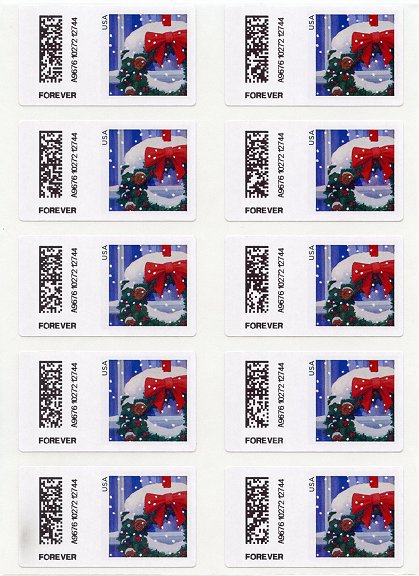 |
When the customer buys stamps, the direct thermal printer inside the postal kiosk, prints the Datamatrix - 2D barcode, the vertical code, and the face value indicator on the labels.
Customers can only obtain stamps with this design with the 'FOREVER' value, which is the identifier of postage for domestic priority ('First-Class') letters up to one ounce, approximately 28 g. In 2016, this postage rate corresponded to 47 cents. Therefore, these are not variable value stamps, because it is not possible to obtain stamps with other face values.
The sheets include five rows and two columns of labels (left) and, after printing, the kiosks cuts the sheets horizontally, so stamps may only be issued in multiples of two. If the customer requests an odd number of stamps, the last label is issued with the text 'THIS BLOCK IS NOT VALID POSTAGE' (upper image), indicating that it has no postage value. |
| Block with two test imprint labels (TEST VEND - VOID), and two blank labels. |
 |
| Christmas 2017, when the USPS kiosks dispensed cookies ! |
For the sixth consecutive year, in 2017 the United States Postal Service (USPS) produced a special edition of self-adhesive labels to be used in many of its SSK (Self-Service Kiosk) postal kiosks during the holiday season.
As in previous years the subject of the labels is related to the Christmas set of 'traditional' stamps for domestic mail. In 2017, the set of four stamps issued on October 5th is dedicated to well-known Christmas carols; 'Deck the Halls', 'Silent Night', 'Jingle Bells' and 'Jolly Old Saint Nicholas'. The designs are by Howard E. Paine, from artworks by Steve McCracken.
The theme used on the SSK kiosks labels is an enlarged detail of the image of the first stamp, 'Deck the Halls', with some Christmas cookies shaped as Christmas trees, stars and a snowman. |
 |
The boxes of labels arrived at the post offices from mid-October, and were available at the kiosks until the end of December or until depletion of stocks.
The SSK kiosks use sheets of ten labels, fan folded and die-cut between sheets. The size of the labels is 47 x 26.50 mm., and are manufactured on thermal paper with a colourless vertical fluorescent strip on the left of the label. The pre-printed design is on the right, and has a glossy surface coating.
The kiosk prints a Datamatrix - 2D barcode, the vertical code, and the 'FOREVER' face value indicator on the labels. This is the only possible value, corresponding to the postage for domestic priority ('First-Class') letters up to one ounce (49 cents, in 2017). |
 |
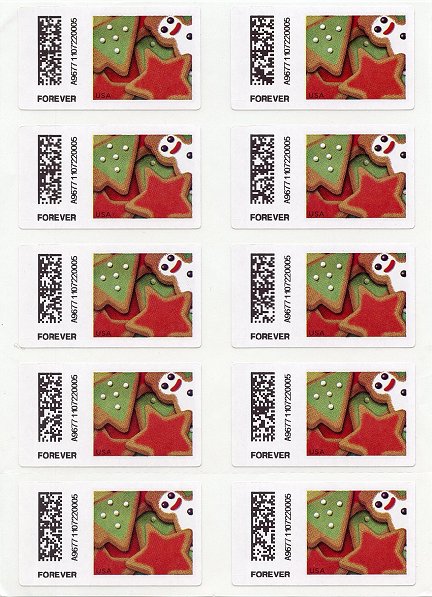 |
The sheets include five rows and two columns of labels (left) and, after printing, the kiosks cuts the sheets horizontally, so stamps may only be issued in multiples of two. If the customer requests an odd number of stamps, the last label is issued with the text 'THIS BLOCK IS NOT VALID POSTAGE' (upper image), indicating that it has no postal value. |
With the collaboration of P. Elias, B. Jehle, L. Nadybal, X. Wang.
ATM Web - Spain and Latin American Postal Services: http://www.ateeme.net
© J. Jove - ATEEME. Variable value stamps study group. All rights reserved
This page was created in November 2004 and last updated:
12.01.18
. English edition rewritten by S. Goodman & J. Gareze (11.01.2018)
|




















